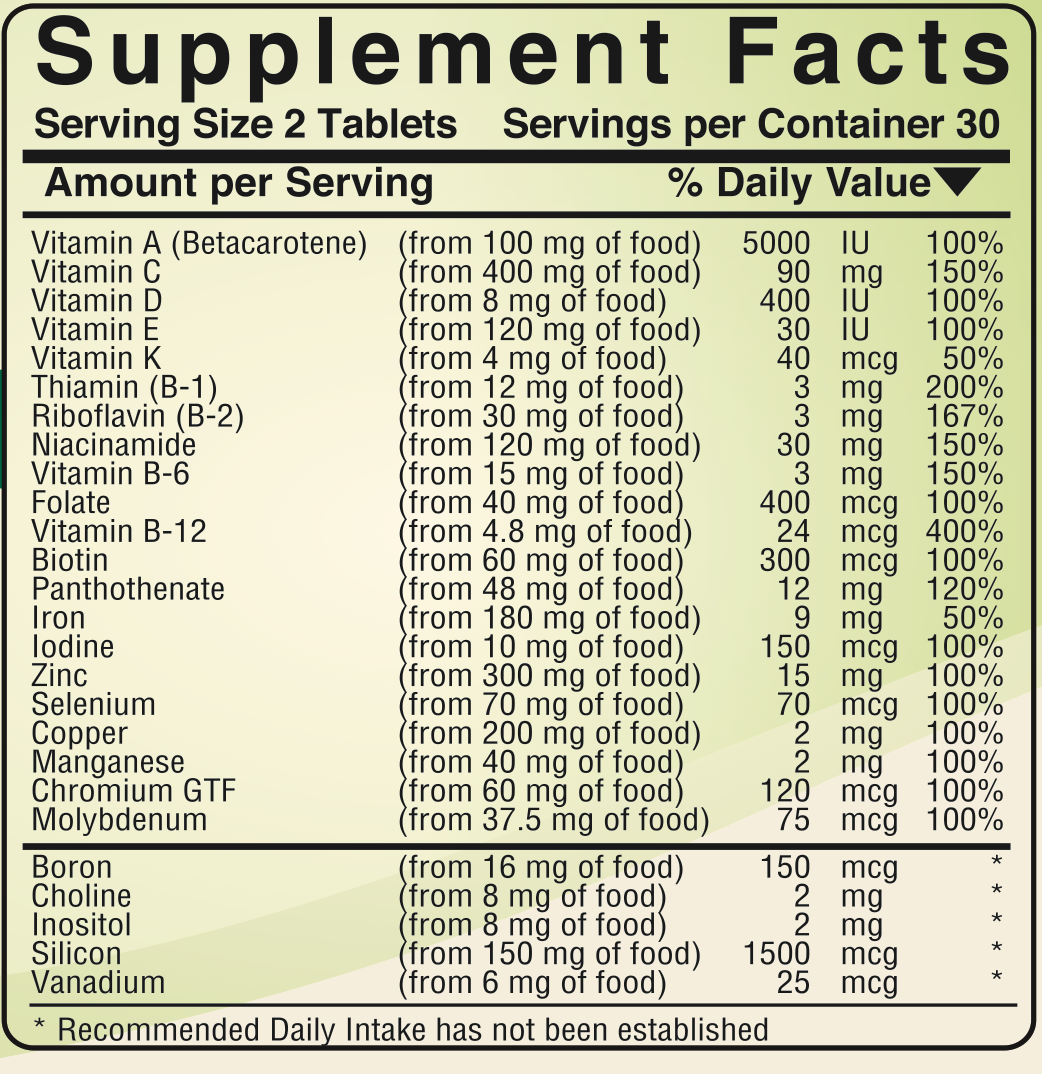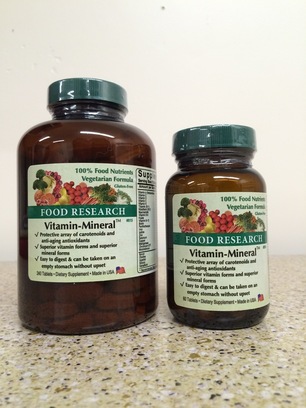
Vitamin-MineralTM
60 Tablets $34.98 240 Tablets $106.98
240 Tablets $106.98
60 Tablets $34.98
Food Vitamins and Minerals ARE Better!
Most multi-vitamin formulas are primarily synthetic (e.g. petroleum-derived) vitamins plus crushed industrial rocks, yet even peer reviewed medical research has concluded that food vitamins are superior to synthetics [1]. Numerous scientific papers have concluded that Foodvitamins and minerals are better than USP isolated ‘nutrients’ because they contain important enzymes, peptides and phytonutrients which are critical to the utilization of vitamins and minerals and are lacking in isolated USP nutrients [e.g. 1,2].
| Vegetarian FOOD Nutrient | Compared to USP/Mineral Salt |
| Vitamin A | More complete, as scientists teach that vitamin A is not an isolate [3] |
| Vitamin B-9 | More utilizable above 266mcg (Recommended Daily Intake is 400mcg) [4] |
| Vitamin C | Over 15.6 times antioxidant effect [5] |
| Vitamin D | Over 10 times the antirachitic effect [6] |
| Vitamin E | Up to 4.0 times the free radical scavenging strength [7] |
| Vitamin K | Safer for children [8] |
| Calcium | 7 times as effective in raising serum ionic calcium levels [9] |
| Chromium | Up to 25 times more bioavailable [10] |
| Iron | Non-constipating, better absorbed [11] |
| Magnesium | Better absorbed and retained [12] |
| Selenium | Nearly 2 times better retained [13] |
| Zinc | Better absorption, better form [14,15] |
The Difference is More than Quantitative
Some have felt that if they take, for example, twice as much of a synthetic vitamin or industrial rock (called a mineral salt) than a Food vitamin or mineral, then it will be just as effective in the body. That is not true. An analogy might be appropriate here. Let’s say two people want to build a computer. One has 100% of all the parts (like in Food nutrients) and the other has 97% of all the parts, but the parts are a lot bigger (like in USP rocks), which computer will work correctly? The one with all the parts! Shouldn’t your body have all the nutritional parts it needs? USP vitamins and minerals are cheap (or not so cheap) industrial imitations of Food vitamins and minerals--they are not Food!
Synthetic vitamins and rocks can have some positive nutritional effects (as well as unnatural residues), yet SYNTHETIC VITAMINS & OTHER ROCKS CANNOT REPLACE ALL THE FUNCTIONS OF FOOD VITAMINS & MINERALS! USP vitamins and minerals are not structurally the same, nor in most cases chemically the same, as Food nutrients. As the aim of supplementation is to provide nutrients which may be missing from the diet (for optimal health), it is logical that Food vitamins and minerals can accomplish this much better than synthetic vitamins or crushed industrial rocks.
Food Vitamins and Minerals Do Not Even Look the Same as USP--SEE THE DIFFERENCE!
The electron microscope photos below reveal that isolated USP form vitamins and mineral salts have a crystalline appearance whereas Food nutrients have more of a rounded appearance (nutrients in Foods are not crystalline):
 |
 |
| Food Vitamin C | Ascorbic Acid |
 |
 |
| Food Vitamin B1 | Thiamine Hydrochloride |
There Are Also Quality of Life Differences! [2]
An in vitro study found that Food Vitamin C has negative oxidative reductive potential (ORP [16], yet the Merck Index reveals that ascorbic acid has positive redox potential [17]. This means that no quantity of USP ascorbic acid can ever match the ability of Food Vitamin C to clean up damage caused by free radicals (“negative ORPs indicate active reducing power, which is immediately capable of antioxidant activity whereas items with positive ORPs are not” [18]). While it is true that both Food and USP vitamin E can reduce some lipids to the same level, this is where the difference ends. The liver has a specific transport protein for natural vitamin E, which it does not have for synthetic vitamin E [7]. Published research suggests that Food vitamin E is up to 4 times better than synthetic vitamin E [7] and that the body apparently tries to rid itself of synthetic vitamin E as fast as it can [19]! In addition, mineral-rich Foods often have specific protein chaperones which aid in mineral absorption and utilization [20]; this may be why minerals in Foods do not have the types of toxicities associated with industrial metals (called mineral salts) [21].
Frankly, there have not been enough long-term studies to show all the benefits of Foodnutrients over the rocks and synthetics commonly used in most research studies (and contained in most supplements). Some studies have found that while consuming a diet high in antioxidant nutrient-containing foods has been shown to reduce cancer risk or Alzheirmer’s, attempts by scientists to replicate those results with USP antioxidant vitamins & minerals do not get the same results [2,18,22]. Food nutrition, or as close to Food as possible, seems to be the logical choice. Why take anything else?

Contains naturally occurring calcium, magnesium, phosphorus, potassium, trace minerals, carbohydrates, lipids, proteins (including all ten essential amino acids), monosaccharides (including all considered essential), and superoxide dismutase as found in enzymatically processed Saccharomyces cerevisiae, acerola cherry, mixed citrus fruits, carrots, broccoli, cabbage, rice, and aloe vera extracts--all the nutrients shown above are contained in these foods. Unlike many so-called “natural” vitamin formulas, Food Vita-Mineral is a food vitamins (and not a synthetic isolate) contains no synthetic USP nutrients, but only contains foods, food complexes, and food concentrates. Studies indicate that Food nutrients ARE better than isolated USP nutrients and MAY BE better absorbed, retained, and utilized than USP nutrients.
Suggested use: 1-3 tablets per day or as recommended by your health care professional. Adjust usage according to nutritional lifestyle requirements.
References
[1] Thiel R. Natural vitamins may be superior to synthetic ones. Med Hypo.2000;55(6):461-469
[2] Franceschi S, et al. Role of different types of vegetables and fruit in the prevention of cancer of the colon, rectum, and breast. Epidemiol, 1998;9(3):338-341
[3] Ross A.C. Vitamin A and Carotenoids. In Modern Nutrition in Health and Disease, 10th ed. Lippincott William & Wilkins, Phil, 2005: 351-375
[4]Lucock M. Is folic acid the ultimate functional food component for disease prevention? BMJ, 2004;328:211-214
[5] Williams D. ORAC values for fruits and vegetables. Alternatives, 1999;7(22):171
[6] Thiel R. Vitamin D, rickets, and mainstream experts. Int J Naturopathy, 2003; 2(1)
[7]Traber MG. Vitamin E. In Modern Nutrition in Health and Disease, 9th ed. Williams & Wilkins, 1999:347-362
[8] Olson R.E. Vitamin K. In Modern Nutrition in Health and Nutrition, 9th ed. Williams & Wilkins, Balt., 1999: 363-380
[9] Hamet P, et al. The evaluation of the scientific evidence for a relationship between calcium and hypertension. J Nutr, 1995;125:311S-400S
[10] Ensminger AH, Ensminger ME, Konlade JE, Robson JRK. Food & Nutrition Encyclopedia, 2nd ed. CRC Press, New York, 1993
[11] Wood R.J., Ronnenberg A.G. Iron. In Modern Nutrition in Health and Disease, 10th ed. Lippincott William & Wilkins, Phil, 2005: 248-270
[12] Rude R.K., Shils M.E. Magnesium. In Modern Nutrition in Health and Disease, 10th ed. Lippincott William & Wilkins, Phil, 2005: 223-247
[13] Biotechnology in the Feed Industry. Nottingham Press, UK, 1995: 257-267
[14] Andlid TA, Veide J, Sandberg AS. Metabolism of extracellular inositol hexaphosphate (phytate) by Saccharomyces cerevisiae. Int J. Food Microbiology. 2004;97(2):157-169
[15] King JC, Cousins RJ. Zinc. In Modern Nutrition in Health and Disease, 10 th ed. Lipponcott Williams & Wilkins, Phil., 2005:271-285
[16] Thiel R. ORP Study on Durham-produced Food Vitamin C for Food Research LLC. Doctors’ Research Inc., Arroyo Grande (CA), February 17, 2006
[17] Budavari S ed. The Merck Index: An Encyclopedia of Chemicals, Drugs, and Biologicals, 12 th ed. Merck & Co, Whitehouse Station (NJ), 1997
[18] Thiel R.J, Fowkes S.W. Can cognitive deterioration associated with Down syndrome be reduced? Medical Hypotheses, 2005; 64(3):524-532
[19] Traber MG, Elsner A, Brigelius-Flohe R. Synthetic as compared with natural vitamin E is preferentially excreted as alpha-CEHC in human urine: studies using deuterated alpha-tocopherol acetates. FEBS Letters, 1998;437:145-148
[20] Rouhi AM. Escorting metal ions: protein chaperone protects, guides, copper ions in transit. Chem Eng News, 1999;11:34-35
[21]Craig EA, Vsosine C, Shilke B. Mitochondrial iron metabolism in the yeast Saccharomyces cerevisiae. Biol Chem 1999;380(10):1167-1173
[22] Rottcamp CA, Nunomura A, Raina AK, et al. Oxidative stress, antioxidants, and Alzheimer’s disease. Alzheimer Dis Assoc Disord, 2000;14(S1):S62-S66
Some of these studies (or citations) may not conform to peer review standards, therefore, the results are not conclusive. Professionals can, and often do, come to different conclusions when reviewing scientific data. None of these statements have been reviewed by the FDA. All products distributed by Doctors’ Research, Inc. are nutritional and are not intended for the treatment or prevention of any medical condition.
 |
|
|
|
|
